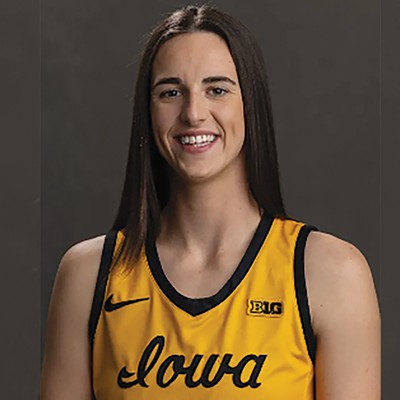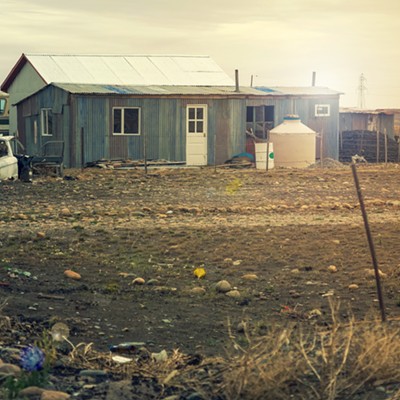U.S. Highway 70 starts in North Carolina and runs west for a couple of thousand miles along the southern part of the United States until it ends just outside of Globe, Ariz. Not far from that terminus, on the east side of the San Carlos Apache Indian Reservation in Graham County, is a stretch of about 20 miles that, on balmy early-autumn nights, is home to an American ritual that is both anachronistic and exhilarating.
Along that Highway 70 corridor are four high schools. The biggest one, Safford, is relatively small as Arizona high schools go. Heading west and then north along the highway, the following three—Thatcher, then Pima, and then Fort Thomas—are progressively smaller still.
The four communities have stark differences: Safford is the county seat; contiguous to Safford, Thatcher is a Mormon community built around Eastern Arizona College; separated from Thatcher by 5 miles of cotton fields is the farming community of Pima; and a few more miles up the road is Fort Thomas, which sits at the far southeast corner of the sprawling San Carlos reservation. They're all quite different, but at least one night a week every fall, they're remarkably similar, because Friday night is Football Night in small-town Arizona.
Actually, Friday night is Football Night everywhere in Arizona, but in the metro areas, it's not like it was in the old days. Thirty or 40 years ago, in Tucson and Phoenix, just about every high school football game drew a crowd of 1,000 or more. Big games drew several thousand, and the occasional Monster Game—a late-season affair pitting, by grace of the schedule, two undefeated teams—would be played in Arizona Stadium and draw close to 20,000 people. While a handful of Tucson-area teams (Ironwood Ridge on the northwest side, Cienega in Vail, and Sunnyside on the southside) still draw relatively large crowds, other schools in town might only pull in a few hundred fans, if they're lucky—even with a winning team.
There are football factories in the Phoenix area that try to fashion themselves after the Texas high school football grotesqueries first popularized (or, more correctly, exposed) in the book and movie (but not the television series) Friday Night Lights. (Just this year, the people of Allen, Texas—an upscale suburb of Dallas—unveiled their new high school football stadium, which seats 18,000 people and cost $60 million.) However, while a few Phoenix-area schools are going big and enjoying success on the field and at the gate, many big-city schools are seeing declines as intense competition for fan interest and entertainment dollars eat into their turnout numbers.
These declines have not reached rural Arizona. All over the state, small schools along the Mexican border, up in the White Mountains, along the Colorado River and scattered throughout the Navajo Nation are packing them in on Friday nights. In these towns and villages, the local high school football field is a gathering spot, a place of unity, energy and community.
On this October night, all four schools in the Gila Valley are playing home football games, a rare occurrence that, mathematically speaking, should only happen five times in a decade. As game time nears, traffic along Highway 70 is especially light for a Friday night. The restaurants along the road through Thatcher and Safford are mostly empty, and there are plenty of seats available at the cineplex, even for the movies that are opening that night.
Enthusiasm is high at three of the schools, but not so much at Safford. Toward the start of the season, the Bulldogs enjoyed a win over much-bigger Douglas, but had lost two of their next three heading into Safford's annual rivalry game with Thatcher. In a game played at Safford before a reported crowd of around 8,000, the Thatcher Eagles pounded the Bulldogs, 51-7, with the final Eagles touchdown bringing about the ultimate indignity, the triggering of the "mercy rule": In Arizona prep football, if a team gets a lead of at least 42 points, the clock runs nonstop so as not to prolong the agony. (It's actually a stupid rule, as it has more to do with stigma than mercy.)
It should be noted that a measure of enthusiasm—across the board and around the entire state—has been eliminated by a wrenching reorganization plan instituted by the Arizona Interscholastic Association, which governs high school sports in the state. For decades, the state's schools were divided according to enrollment figures into classes, and then subdivided into conferences. It worked out perfectly in the Gila Valley. Safford was 3A; Thatcher was 2A; and Pima and Fort Thomas were 1A. Every year, it was possible (and often probable) that three of the schools would win their respective conference titles.
However, the AIA eliminated all of that and replaced it with an unfathomable system of divisions and sections. It did away with conference and region championships. Last year, the AIA was blasted for using a flawed mathematical formula to determine which teams got to go to the state playoffs. This year, it's been replaced with another formula, the particulars of which are being kept secret.
On this Friday night, Safford is hosting smaller-school Benson, but things won't get much better than the previous week. (After absorbing that pasting at the hands of Thatcher, Safford would not win another game and would finish the year at 2-8.)
At the other end of the corridor, Fort Thomas is celebrating its homecoming game. Homecoming floats, mostly consisting of brightly decorated flatbed and pickup trucks, are lined up on the track, just north of the football field. A crown awaiting this year's queen rests on a velvet pillow near the field.
While Fort Thomas is best known for its girls' and boys' basketball teams, the football stadium is packed, and the crowd is raucous. The cheerleaders, eschewing the big-city fashion trend toward hoochie, are demurely dressed in shorts, T-shirts and long socks. In a phenomenon that is apparently universal from Pop Warner up through high school, college and into the NFL, the cheerleaders are almost completely ignored by the people in the stands.
On the field, things are going quite well for the Apaches. (Yes, the Apaches. Apparently, it's OK, even in this day and age, to call your sports teams the Apaches if you are, indeed ... Apaches.) They're putting the hammer down on Patagonia, and this game is heading for an early invoking of the mercy rule.
Because of small enrollment numbers and subsequent small rosters, the smallest schools in Arizona have always played eight-man football, with five linemen and three backs instead of the traditional seven-and-four arrangement. The eight-man game, which is played on a smaller, 80-yard field, is a wide-open affair. Leads can evaporate, and scores can get out of hand in a hurry. It's not uncommon to see scores in the range of 72-48, and close games are rare.
Fort Thomas comes into the game with a record of 3-3. Two of its wins are by 40 and 38 points, but its three losses are by six, four and six points. "It's been a tough season," says Lee Haws, who is the school's girls' basketball coach and athletic director. "All three of those games went right down to the wire. We could be having one of the best seasons ever, but instead, we won't even make the playoffs."
One team that will make the playoffs is Pima, which is rolling through an undefeated regular season. Pima is one of the largest schools that play eight-man football. Its roster is almost as big as the entire enrollment of one of the two schools against which it is competing tonight. (Bowie and San Simon high schools are just a few miles apart on Interstate 10 near the New Mexico state line. Their individual enrollments are so small that the AIA allows them to join forces in a single, more-competitive squad.)
That's not going to help against Pima. The Roughriders' closest game of the year to that point was a 44-12 win over Chandler Prep in the season opener. Since that relative squeaker, Pima had won five more games by an average score of 59-12. Against Bowie/San Simon, it's already 52-0 by halftime. The Roughriders are being led by a kid whose moniker gives him instant entry into the Cool Sports Names Hall of Fame—senior running back Jhett Judd.
Standing along the Pima sideline with a big ol' cowboy hat on is Scott Alder. By day, he is a ditch boss for the Gila Valley Irrigation District. By (Friday) night, he is Stat Man. His wife, Joyce, a retired teacher who taught English at Pima Junior High, shouts out the yards and jersey numbers.
Weird fact: They live on Alder Lane.
Weirder fact: There is a small residential street that runs along the north side of the football field. On the far side of the street are houses, but on the side of the street next to the school fence is a long stretch of dirt on which, someday, a sidewalk might be built. People actually park along the fence and sit in the beds of their pickup trucks or on lawn chairs to watch the game from really bad end-zone seats, rather than spend the few bucks it costs to get in the game. I didn't catch the name of the street, but I'm guessing it's something like Cheapskate Road.
When the Roughriders host a state playoff game, the AIA (which collects and keeps the gate receipts from all state tournament games and meets) has that fence covered so no one can watch the game for free.
The chain gang (the people who man the first-down sticks and yard markers) consists of Carol Anne Weech; her cousin Daryl; her father, Rodell; and another cousin, Darwin. The Weech family has been doing the sticks at Pima games for as long as anyone can remember, probably more than 50 years. Some time back, Daryl replaced his father, Bulan, and Rodell replaced his father, Bertrell. The joke is that Carol Anne was added to the crew to satisfy some Title IX requirements. Daryl likes to tell the officiating crew that the chain gang has a combined 90 years of experience.
One last thing on that: No one in the Weech family has ever taken a penny for doing the sticks, meaning that over the past half-century, they're probably saved the school district something like $20,000.
It's Senior Night at Pima, so all the seniors who participated in fall sports activities (that includes members of the marching band and cheerleaders, as well as football and volleyball players) will be introduced at halftime. Each kid is flanked by parents, and they walk out to the center of the field to polite applause.
After having watched, for many years, crime reports on the local TV news, and/or college football games, I'm constantly amazed at how many young people don't share a last name with their respective mothers. I'm not sure whether it's a cause or an effect. But watching the steady stream of people on the Pima football field was jarring. Every kid had the same last name as the parents (and every kid had parents). It was disconcerting; how is that even possible?
After the Senior Night stuff is all done comes the highlight of the evening: Taking the field for halftime festivities is the Pima High School Marching Band. There are a few kids in band uniforms, a couple of flag girls and, carrying a tuba the size of a Mini Cooper, the football team's starting middle linebacker, William Hemphill. While his teammates make their way to the locker room, he has removed his helmet, shoulder pads and jersey, and he has joined the band.
The theme of the night is James Bond music. (Hey, that means that the Weech family was doing the sticks when Dr. No came out!) Lugging the tuba, Hemphill marches up and back, hitting every note and almost every mark. It's one of the coolest things I've ever seen on a football field. It's guaranteed that you're not going to see something like that in a big city.
What's sad is that, in previous years, several members of the football team and even a couple of cheerleaders had played in the marching band. This year, an odd breeze of Too Cool-ism wafted through town, and all of the other footballer/band geeks opted out. Some even tried to talk Hemphill out of staying with it, but he had made a commitment, and that was that.
As soon as the band is done, Hemphill sets the instrument aside, puts his pads and jersey back on, straps on his helmet, and is ready for the second half.
In the second half of Thatcher's game, the team is having trouble putting away the visitors from Willcox. Maybe it's an inevitable emotional letdown after hitting that high the previous week against Safford. Whatever the case, the thousands of Thatcher faithful who have shown up at John Mickelson Field on the campus of Eastern Arizona College are getting restless.
(Thatcher High School doesn't have a football stadium. It has practice fields, but uses the EAC facility for home games.)
It turns out that Willcox is good. The Cowboys came to town with a gaudy 5-1 record, the same mark as Thatcher. The two teams trade turnovers early in the third quarter, but then Thatcher mounts a long drive. The Eagles quarterback is senior Presley Motes (not a shoo-in for that Name Hall of Fame, but certainly a nominee). Motes engineers a scoring drive, and the Eagles hold on for a 27-13 win. (Both Thatcher, 9-1, and Willcox, 7-3, will reach the state playoffs.)
After all the games are over, the Gila Valley squads have gone 3-1 on the night. Surely, the celebrating must follow. In better days, the Safford faithful would take over the Sonic, park their trucks, blast their music and consume their weight in tater tots. However, the Sonic is pretty dead on this night. The visiting teams hit the McDonald's or the Burger King on their way out of town.
After Fort Thomas dispatches Patagonia, most of the players and cheerleaders catch a bus back to Bylas, where most of them live. There's no party, not even a fast-food place at which to hang out. The Thatcher crowd hits a couple of fast-food joints along Highway 70, but nothing special.
And the members of the squad from Pima, the team that would go on to play in the state championship game (a loss to Desert Christian)? They go to Denny's.











